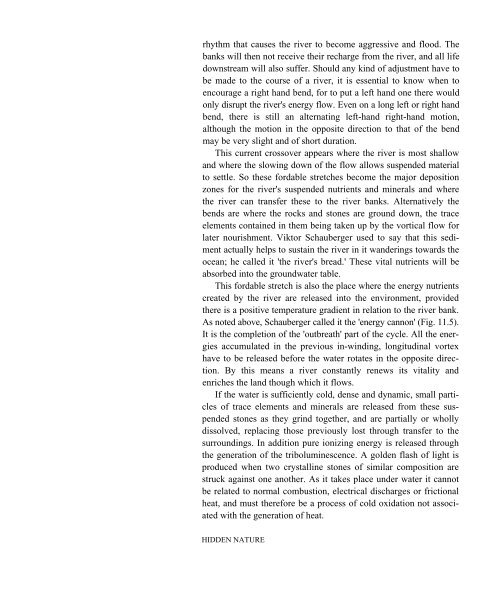levitational current - Free Energy
levitational current - Free Energy
levitational current - Free Energy
Create successful ePaper yourself
Turn your PDF publications into a flip-book with our unique Google optimized e-Paper software.
hythm that causes the river to become aggressive and flood. The<br />
banks will then not receive their recharge from the river, and all life<br />
downstream will also suffer. Should any kind of adjustment have to<br />
be made to the course of a river, it is essential to know when to<br />
encourage a right hand bend, for to put a left hand one there would<br />
only disrupt the river's energy flow. Even on a long left or right hand<br />
bend, there is still an alternating left-hand right-hand motion,<br />
although the motion in the opposite direction to that of the bend<br />
may be very slight and of short duration.<br />
This <strong>current</strong> crossover appears where the river is most shallow<br />
and where the slowing down of the flow allows suspended material<br />
to settle. So these fordable stretches become the major deposition<br />
zones for the river's suspended nutrients and minerals and where<br />
the river can transfer these to the river banks. Alternatively the<br />
bends are where the rocks and stones are ground down, the trace<br />
elements contained in them being taken up by the vortical flow for<br />
later nourishment. Viktor Schauberger used to say that this sediment<br />
actually helps to sustain the river in it wanderings towards the<br />
ocean; he called it 'the river's bread.' These vital nutrients will be<br />
absorbed into the groundwater table.<br />
This fordable stretch is also the place where the energy nutrients<br />
created by the river are released into the environment, provided<br />
there is a positive temperature gradient in relation to the river bank.<br />
As noted above, Schauberger called it the 'energy cannon' (Fig. 11.5).<br />
It is the completion of the 'outbreath' part of the cycle. All the energies<br />
accumulated in the previous in-winding, longitudinal vortex<br />
have to be released before the water rotates in the opposite direction.<br />
By this means a river constantly renews its vitality and<br />
enriches the land though which it flows.<br />
If the water is sufficiently cold, dense and dynamic, small particles<br />
of trace elements and minerals are released from these suspended<br />
stones as they grind together, and are partially or wholly<br />
dissolved, replacing those previously lost through transfer to the<br />
surroundings. In addition pure ionizing energy is released through<br />
the generation of the triboluminescence. A golden flash of light is<br />
produced when two crystalline stones of similar composition are<br />
struck against one another. As it takes place under water it cannot<br />
be related to normal combustion, electrical discharges or frictional<br />
heat, and must therefore be a process of cold oxidation not associated<br />
with the generation of heat.<br />
HIDDEN NATURE








![The Big Lie 9-11 and Government Complicity in Mass Murder [PDF]](https://img.yumpu.com/50957077/1/190x245/the-big-lie-9-11-and-government-complicity-in-mass-murder-pdf.jpg?quality=85)








